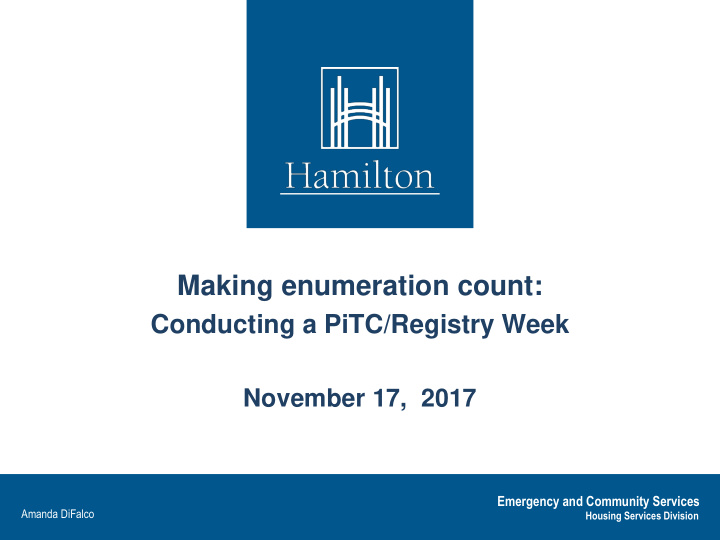



Making enumeration count: Conducting a PiTC/Registry Week November 17, 2017 Emergency and Community Services Amanda DiFalco Housing Services Division
Presentation Overview 1 Hamilton Context 2 Registry Week Components ✓ Stakeholder Engagement ✓ Volunteer Recruitment ✓ Surveying ✓ Volunteer & Community Debriefs ✓ Registry Week: Systems Influence ✓ Common Questions & Concerns 3 Questions 2
Enumeration in Hamilton Aboriginal Point-in-Time Count (2015) 131 people surveyed 20K Homes Pilot Community (2015) Registry Week 454 people surveyed 1 st National PITC (2016) Combined PITC / Registry Week 504 people surveyed 3
4
Hamilton’s Enumeration Objectives ✓ Connect with as many people as possible experiencing homelessness ✓ Understand the scope of need in our community and the levels of vulnerability ✓ Inform planning and prioritization of appropriate responses 5
Hamilton’s Enumeration Strategy ✓ Driving your vision forward ✓ Strategic alignment with policy/practices ✓ Education and awareness ✓ Building a system 6
2016 Results • 504 unique individuals surveyed • Commitment to house 138 high acuity individuals experiencing chronic/episodic homelessness in 2016 ✓ 218 housed, exceeding target by 58% 7
Registry Week Components 8
Project Mangement • Have a point person (project manager function) • Project team – who’s on it, why, what’s their role? • Workplan • Indigenous coordinator • External support (e.g. consultant) 9
1. Stakeholder Engagement 10
…Stakeholder Engagement cont’d What worked: • Leveraging existing community networks/committees • Designated Communications Focal Point • Broad volunteer recruitment • Promoting surveying to potential respondents What we learned: • Projecting live Twitter feed at events helped #20KHomes become the top trending item on Twitter in Hamilton • Importance of highlighting the voice of lived experience • Be strategic about who you engage (eg hospitals) 11
Working with Hamilton’s Indigenous Community ✓ It’s not a one size fits all approach ✓ Meaningful engagement ✓ Recognize self-determination and autonomy ✓ Financial commitments to support the work 12
2. Volunteer Recruitment • Advertise and cascade widely • Organizations with similar interests (schools, religious organizations, family/friends) • Min. age requirements • Non survey roles (registration, coordination) • Training team leads and volunteers ✓ Campaign overview ✓ Roles and responsibilities ✓ Engagement strategies ✓ Overview of survey Q’s 13
…Volunteer Recruitment cont’d What worked: • Designated person responsible for volunteer recruitment • Administrative support to manage incoming applications • Broad distribution of a recruitment poster • Media release • Volunteers who didn’t want to participate in media What we learned: • Number of volunteer applications exceeded expectations • Attrition rate was approximately 20% • Consent for future communication 14 • Volunteer accessibility and vehicle usage
3. Surveying • 4 shifts over two days (24hrs*) • Streets, Shelters, Drop ins, Day programs, Transitional Housing, Community Health Centre, “neutral” space (e.g. library), hospitals, “magnet event” • GIS Mapping for street surveys • PiTC +VI- SPDAT + *Local Q’s* (10 -15min) • Honorarium $10Tim Horton’s gift card • Each team had their own: orientation package & box of supplies 15
S urveying cont’d • Lived experience engagement • One script and one consent (2 parts – PiTC, VI-SPDAT) • Included name of volunteer • Included location of survey (street intersection, agency etc) • Volunteer training (engagement, package, sensitive questions, role play) 16
S urveying cont’d What worked: • Combined survey tool (PiTC/Registry) • Team leads and Indigenous Advisors • The use of different VI-SPDAT (e.g. youth, family) • Data Management What we learned: • Clarity around consent • Contact for person being surveyed • Manual vs electronic • Removing duplicates from data 17
4. Volunteer & Community Debriefs Volunteer Debrief • Volunteer debrief & evaluation • Counselling support Community Debrief • City hall at the end of the Registry Week • Call to Action: Urgent and Immediate Action to House 18
A Call to Action • Driver for: ✓ Urgent and immediate action to house ✓ Transformational change at systems level ✓ Prioritizing individuals for housing based on current system resources and work towards the ideal https://www.Hamilton.ca/social-services/housing/20000- homes-campaign 19
5. Registry Week: Systems Influence • Commitment to vision • Strengthened partnerships (e.g. LHIN’s) • Community Self Assessment tool • Targeted Funding – IAH, HFG • Implementation of SPDAT • Housing-based Case Management • The role of the emergency shelter system • Shelter Diversion • Integrated priority list • Building a system of care model • Coordinated Intake and Assessment • Rapid Rehousing 20
6. Common Questions & Concerns • Nature of survey questions • Ethical concerns around informed consent • Use of volunteers • Asking peoples’ names • Raising expectations • Addressing needs without additional resources • Next steps 21
Questions 22
Thank you Amanda DiFalco Manager, Homelessness Policy and Programs Amanda.DiFalco@hamilton.ca 905-546-2424 ext. 3132
Recommend
More recommend